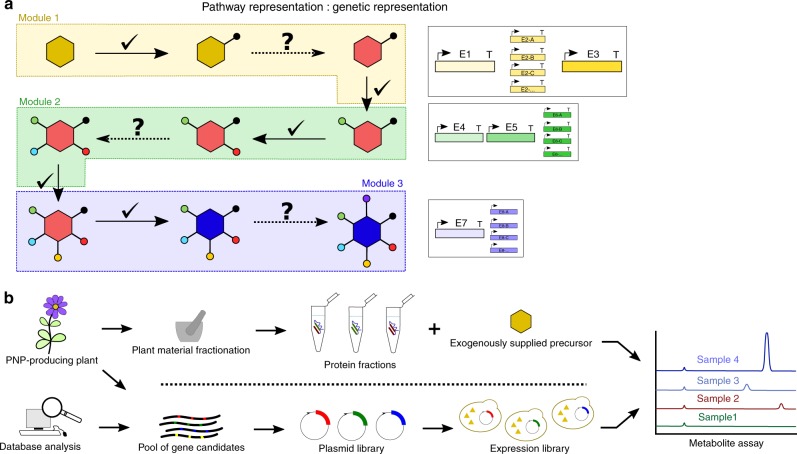CD Biosynsis is a leading research organization in the field of enzyme design and evolution, with long and in-depth experience in directed enzyme evolution. Our professional research team provides highly-quality services to help researchers improve enzyme-substrate reactivity and provide valuable insights for the rational design of enzymes with better properties or new functions.
Overview
Enantioselective covalent catalysis is a field of organic chemistry that involves the use of chiral catalysts to promote reactions in a selective manner, favoring the formation of one enantiomer over the other. Enantioselective catalysis is important in the synthesis of chiral compounds, which are critical in pharmaceuticals, agrochemicals and materials science.
 Fig 1. Pathway engineering can be broken down into enzyme module and discovery components. (Cravens A, et al., 2019)
Fig 1. Pathway engineering can be broken down into enzyme module and discovery components. (Cravens A, et al., 2019)
Our Services
Based on our advantages in the field of computer-aided design and AI applications, the EnzymoGenius™ platform is able to provide enzyme designing services for enantioselective covalent catalysis.

- Select Starting Enzymes
Firstly, an enzyme with some relevance to the reaction or substrate is selected as the starting enzyme. The starting enzyme can be a natural enzyme or an engineered variant with modification potential.
- Identify Chiral Centers
Identify chiral centers in substrate molecules and analyze reaction mechanisms and identify the steps involved in forming covalent bonds. Understand transition state structures and factors that contribute to enantioselectivity.
- Computational Modeling Prediction
Use computational methods such as molecular docking, molecular mechanics simulations, or other molecular dynamics approaches to model enzyme-substrate interactions as a way to help predict binding modes and energies for different enantiomers.
- Site-Directed Mutagenesis
Based on the computational predictions, mutations are introduced in the active site of the target enzyme with the aim of modifying residues that may affect enantioselectivity.
- Transition State Stabilization
Design of active sites to stabilize the transition state of the desired enantiomer. This step usually introduces functional groups that can interact specifically with the transition state to improve enantioselectivity.
- Characterization
Characterize engineered enzymes to assess their catalytic activity, substrate specificity, stability and enantioselectivity. Compare the performance of engineered enzymes with wild-type or unmodified enzymes.
- Structural Analysis
Through X-ray crystallography or NMR studies, it is possible to gain insight into the structural changes induced by mutations and thus determine the three-dimensional structure of the engineered enzyme.
Advantages of Enantioselective Covalent Catalysis
- Efficiency
Enantioselective covalent catalysis can minimize the number of steps required for chiral resolution or isolation, thereby significantly increasing the efficiency of the synthetic route.
- Reduced Environmental Impact
Enantioselective catalysis usually allows reactions to take place under milder conditions, thus reducing the need for harsh reagents or extreme reaction conditions.
- Atom Economy
Enantioselective covalent catalysis can minimize the side-product generation and thus promote atom economy.
CD Biosynsis strives to offer comprehensive and reliable enzymes for enantioselective covalent catalysis for various applications, whether academic research, industrial applications, or biotechnological development, our services are tailored to meet your specific requirements. Our team is ready to assist you and provide the insights you need to achieve your goals. If you are interested in our services, please don't hesitate to contact us.
Reference
- Cravens A, et al. Synthetic biology strategies for microbial biosynthesis of plant natural products. Nat Commun. 2019,10(1):2142.

































 Fig 1. Pathway engineering can be broken down into enzyme module and discovery components. (Cravens A, et al., 2019)
Fig 1. Pathway engineering can be broken down into enzyme module and discovery components. (Cravens A, et al., 2019)